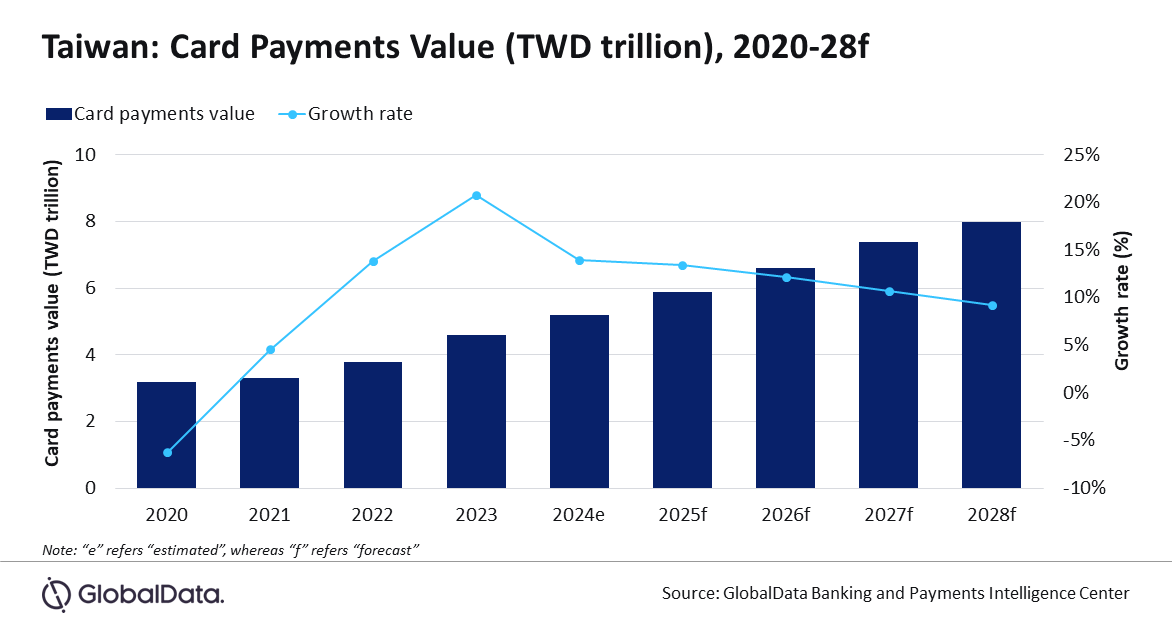
The Taiwan card payments market is forecast to grow by 14% to reach TWD5.2trn ($167.6bn) in 2024, supported by a constant consumer shift towards electronic payments, according to GlobalData, publishers of EPI.
GlobalData Payment Cards Analytics
GlobalData’s Payment Cards Analytics reveals that card payment value in Taiwan registered a growth of 13.9% in 2022, driven by a rise in consumer spending. The value grew further to register a growth of 20.8% to reach TWD4.6trn ($146.9bn) in 2023.
Ravi Sharma, Lead Banking and Payments Analyst at GlobalData, said: “Taiwan’s payment card market is highly penetrated, with each individual holding more than seven cards on average. Cards are also increasingly being used for payments as consumers steadily replace cash transactions with electronic payments, with payment cards being the major beneficiary. This shift in consumer preference can be attributed to the efforts of the government and financial institutions to boost awareness. Banks and payment card issuers providing various benefits and discounts with payment cards also play a prominent role.”
Cash use declines but still accounts for 42% of payments volume
Cash still plays a key role in the Taiwan payment market, accounting for more than 42% of the total payment volume in 2023. However, post Covid-19 pandemic, digital payments have taken a prominent role, significantly reducing reliance on cash transactions. Card payments are on the rise, driven by a rising banked population and a growing inclination towards electronic transactions.
The government is proactively undertaking regulatory measures to increase financial inclusion, decrease reliance on cash, and drive electronic payments. The introduction of the Digital Nation and Innovative Economic Development Plan (2017-2025) is facilitating the growth of Taiwan’s digital economy and fostering the development of digital payment technologies.
In January 2024, The Financial Supervisory Commission set a new target to achieve eight billion non-cash payment transactions by 2026. With these growth initiatives, Taiwan is on the path towards a cash-light economy, thereby benefiting card payments.
How well do you really know your competitors?
Access the most comprehensive Company Profiles on the market, powered by GlobalData. Save hours of research. Gain competitive edge.

Thank you!
Your download email will arrive shortly
Not ready to buy yet? Download a free sample
We are confident about the unique quality of our Company Profiles. However, we want you to make the most beneficial decision for your business, so we offer a free sample that you can download by submitting the below form
By GlobalDataContactless rise boosts cash displacement
The rising usage of contactless cards is also contributing to the overall card payments. Taiwan is one of the key markets for contactless payments in Asia-Pacific, with consumers increasingly using it for payments. Meanwhile, contactless payments are gradually gaining popularity amid consumers’ growing demand for convenience and security. In August 2022, CTBC Bank partnered with the Malaysian fintech company Soft Space to launch its Tap to Phone service for taxis in Taiwan. The service allows CTBC Bank customers to tap their payment cards mobile phones on the taxi driver’s mobile phone to settle their fares.
Sharma added: “The Taiwan card payments market, which was affected by the Covid-19 pandemic, returned to growth trajectory with impressive growth in subsequent years, supported by a rise in economic activity and consumer spending. The market is forecast to grow at a compound annual growth rate (CAGR) of 11.4% between 2024 and 2028 to reach TWD8trn in 2028.”








